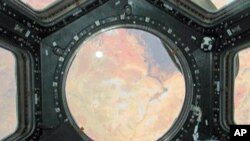NASA astronauts Shannon Walker, Doug Wheelock and Tracy Caldwell Dyson have spent months living on the International Space Station. Our reporter spoke to the trio aboard the space station about the ups-and-downs of life 350 kilometers above the Earth.
The International Space Station is an orbiting laboratory that serves as home and workplace to as many as six crew members at a given time. It travels at the speed of 28,000 kilometers per hour, orbiting the Earth 16 times each day.
That's roughly the equivalent to traveling between the Earth and the moon and back in about a day's time.
And while they are in space, the astronauts conduct research experiments, eat, sleep, exercise and even send messages to online followers on Twitter.
Astronaut Doug Wheelock has been posting photos he has taken in space, some showing islands in turquoise water beneath wispy clouds, or the cluster of bright lights that is New York City at night, or the white swirl of a hurricane gathering strength.
Tracy Caldwell Dyson says it is magical to look down on the Earth from such a great height.
"To be able to look at that view just about any time we want to is one of the most gracious gifts we've been given up here," said Tracy Caldwell Dyson.
Caldwell Dyson, who arrived at the space station in April, says the crew gets by with help of friends on the ground.
"We've got a great psych support team at home that really takes care of us, and family and friends who help supply little goodies for us," she said.
Those goodies, which include food and presents for those who have celebrated a birthday on orbit, come on resupply vehicles.
Wheelock, who arrived at the station in June with astronaut Shannon Walker, said he was very pleased when a resupply vehicle arrived earlier this month.
"Right on very top, as you open the hatch, there are fresh fruits and vegetables that are in there," said Doug Wheelock. "We have gone months without being able to smell the smell of a fresh apple or something and so that was very exciting."
It was a piece of fruit that tempted him first.
"A nice juicy apple, and it was wonderful," he said.
Astronaut Shannon Walker says their meals are usually military rations that come in pouches or NASA developed rehydratable foods, which she described as "pretty tasty."
"Well, eating is very similar to eating on Earth," said Shannon Walker. "Of course, there is no gravity, so your food does float around. So you have to be a little bit more careful that it doesn't go flying off your fork or spoon."
Caldwell Dyson says they have all experienced some weightloss in space. NASA says astronauts typically exercise two hours each day because prolonged weightlessness can result in a loss of muscle and bone density. Because of the lack of gravity, the astronauts' bones do not have to support the weight of their bodies.
The lack of gravity also means astronauts do not walk but float from one place to another. This means they don't travel upright, so they can be facing a number of directions when they enter a module.
Wheelock says the different perspectives can be confusing at first, and can even make the space station seem larger than it is.
"For me, it took about 30 days to where I really felt like I could come into a module, whether I'm on the ceiling or the deck or the starboard or port side - it didn't really matter - and your brain can just very quickly adapt to the orientation you're coming in, " said Wheelock. "It takes about 30 days, something like that. And after that period of time, then you begin to wonder about 'Boy, what's it going to be like when I get back under gravity, and get back home, and I can't do this and, you know, I can't crawl on the ceiling in my home?' "
At the end of the day, Walker says astronauts retire to their small personal quarters.
"My sleeping bag is affixed to a wall and I climb inside and sort of float around in the sleeping bag at night while I'm sleeping," said Walker.
Caldwell Dyson's mission ended this week, meaning it is time that she and two Russian crewmates say good-bye to the space station. She says she will miss looking out the window and seeing the cosmos from an astronaut's perspective.
"And then just the sun rising and setting and the way it looks on the planet makes it look like the most peaceful thing you've ever seen," she said.
Another crew comprised of a NASA astronaut and two Russian cosmonauts will head up to the space station in about two weeks.







